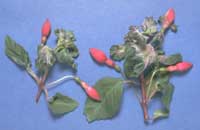

| Home |
| About Us |
| Growing |
| News |
| Shows |
| Varieties |
| Contacts |
| Links |
Fuchsia Gall Mite
|
|
This pest was detected in mainland U.K. in September 2007. America has had it for over 25 years and they still grow Fuchsias so all is not lost. What are Fuchsia Gall Mites ? - They are so small you will need a microscope to see them. Gall Mites are members of the spider family and have a worm-like whitish body with two pair of legs. Gall Mites feed on new growth and sooner or later the female lays eggs, which hatch in 1 --- 2 weeks. As the new leaves or buds start to grow each gall mite punctures the new growth and starts injecting a growth hormone substance that causes the plant tissue to swell and become disfigured. In 2 --- 4 weeks the babies become adults and move to new locations on the plant. How to identify gall mite damage - The plant parts are fused together, they are also swollen and twisted, infected areas look hairy and can look reddish. Some Fuchsias are more resistant than others - so the symptoms can be more or less obvious. It is a notifiable pest so even if found at a minimal stage then DEFRA (in Scotland SEERAD) must be contacted for advice etc.. How can Gall Mites be spread ? In America it is believed that it is spread by humming birds, bees and the wind, but most frequently by humans as they move from plant to plant, pinching out or taking cuttings etc.. So what can we do ? - Be vigilant, check all your plants weekly. Keep cool, isolate any suspect plant from others - if possible in a place with no wind. Change clothing, wash your hands, clean your shoes and clean and tools with alcohol. Contact DEFRA (in Scotland SEERAD) if you suspect gall mite. Hope for a cold winter - they do not like cold weather as their minimal temperature for survival is 5 degrees C. Only buy plants from sources you can be sure of. |
|
| Other information sites for Gall Mite :- | ||
|
Back to Top
|
